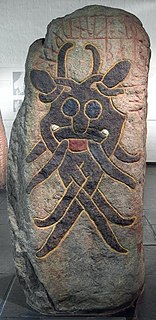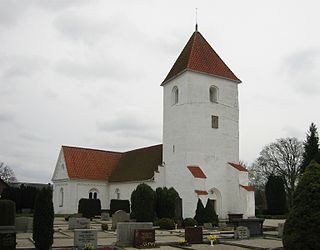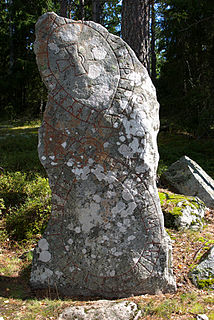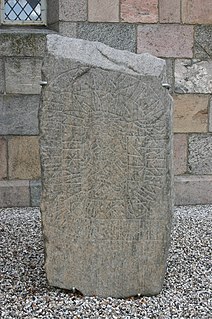
A housecarl was a non-servile manservant or household bodyguard in medieval Northern Europe.

Danish Runic Inscription 66 or DR 66, also known as the Mask stone, is a granite Viking Age memorial runestone that was discovered in Aarhus, Denmark. The inscription features a facial mask and memorializes a man who died in a battle.

The Gunderup Runestone, or DR 143, is located in Gunderup, North Jutland County, Jutland, Denmark. It is notable because it is one of few runestones raised in commemoration of a woman.

The Norra Härene Runestone, designated as Vg 59 by Rundata, is a Viking Age memorial runestone that is located on the grounds of Dagsnäs Castle, which is about seven kilometers south of Skara, Västra Götaland County, Sweden, in the historic province of Västergötland.

The Hedeby stones are four runestones from the 10th century found at the town of Hedeby in Northern Germany. This area was part of Denmark during the Viking Age.

The Hällestad Runestones are three runestones located in the walls of Hällestad Church in Torna-Hällestad, about 20 kilometers east of Lund in Skåne, southern Sweden. Their Rundata identifiers are DR 295, 296, and 297. DR 295 is notable because it is held to be raised in memory of a warrior who fell in the legendary Battle of the Fýrisvellir, near Uppsala, Sweden between the Jomsvikings led by Styrbjörn the Strong and Styrbjörn's uncle Eric the Victorious, the king of Sweden, c. 985. The other stones were raised by the same people, and they probably formed a monument together in memory of comrades lost in the battle. The Karlevi Runestone, the Egtved Runestone and the Sjörup Runestone may be connected to them.
The England runestones are a group of about 30 runestones in Northern Europe which refer to Viking Age voyages to England. They constitute one of the largest groups of runestones that mention voyages to other countries, and they are comparable in number only to the approximately 30 Greece Runestones and the 26 Ingvar Runestones, of which the latter refer to a Viking expedition near the Caspian Sea. They were engraved in Old Norse with the Younger Futhark.

Félag was a joint financial venture between partners in Viking Age society.

Sö 292 is the Rundata catalog number for a Viking Age memorial runestone located in Bröta, which is about six kilometers southwest of Väländan, Stockholm County, Sweden, in the historic province of Södermanland.

Östergötland Runic Inscription MÖLM1960;230 or Ög MÖLM1960;230 is the Rundata catalog number for a memorial runestone that is located near a church in Törnevalla, which is 2 kilometers east of Linghem, Östergötland County, Sweden, which was in the historic province of Östergötland. The runestone has an inscription which refers to a Viking Age mercantile guild and depicts a ship.

The Skern Runestone, designated as Danish Runic Inscription 81 or DR 81 in the Rundata catalog, is a Viking Age memorial runestone located in the small village of Skjern, Denmark between Viborg and Randers. The stone features a facial mask and a runic inscription which ends in a curse. A fragment of a second runestone designated as DR 80 was also found in Skjern.

The Bjäresjö Runestones are three Viking Age memorial runestones originally located adjacent to Bjäresjö Church in Bjäresjö, which is about 3 kilometers northwest of Ystad, Skåne County, Sweden. Two of the stones were discovered near the church, and two of the stones have been moved to other nearby locations. Although these three stones are located in Sweden, they have been given Danish designations because Scania was part of the historic Denmark.

The Fölene Runestones are two Viking Age memorial runestones which are located near the church in Fölene, which is about 2 km (1.2 mi) west of Herrljunga, Västra Götaland County, Sweden, which was in the historic province of Västergötland. The stones are memorials to two men who were described as holding the title drengr.
The Bjärby Runestones are two Viking Age memorial runestones located near Grästorp, Sweden, in Bjärby synod, which was in the historic province of Västergötland. The two stones are memorials to men who held the titles thegn and drengr, and one has a depiction of the hammer of the Norse pagan deity Thor.

The Ballstorp Runestone, listed as Vg 62 in the Rundata catalog, is a Viking Age memorial runestone located on the grounds of the ruins of a church in Ballstorp, which is about 8 kilometers northwest of Floby, Västra Götaland County, Sweden, which is in the historic province of Västergötland.

The Västra Nöbbelöv Runestone, listed as DR 278 in the Rundata catalog, is a Viking Age memorial runestone located in Västra Nöbbelöv, which is about 3 kilometers east of Skivarp, Skåne County, Sweden, and was in the historic province of Scania.

The Ålum Runestones are four Viking Age memorial runestones which are located at the church in Ålum, which is 9 km west of Randers, Denmark. One of the stones refers to a man with the title drengr and two of the other stones were raised by the same family.

The Asferg Runestone, listed as DR 121 in the Rundata catalog, is a Viking Age memorial runestone found at Asferg, which is about 10 km northeast of Randers, Aarhus County, Region Midtjylland, Denmark.

Västergötland Runic Inscription 90 or Vg 90 is the Rundata listing for a Viking Age memorial runestone located in Torestorp, which is about three kilometers northwest of Gudhem, Västra Götaland County, Sweden, and in the historic province of Västergötland.

The Glemminge stone or DR 338 is a Viking Age runestone engraved in Old Norse with the Younger Futhark runic alphabet. It is found in the wall of Glimminge church in Scania, in Ystad Municipality in Sweden. The style of the runestone is the runestone style RAK.


















